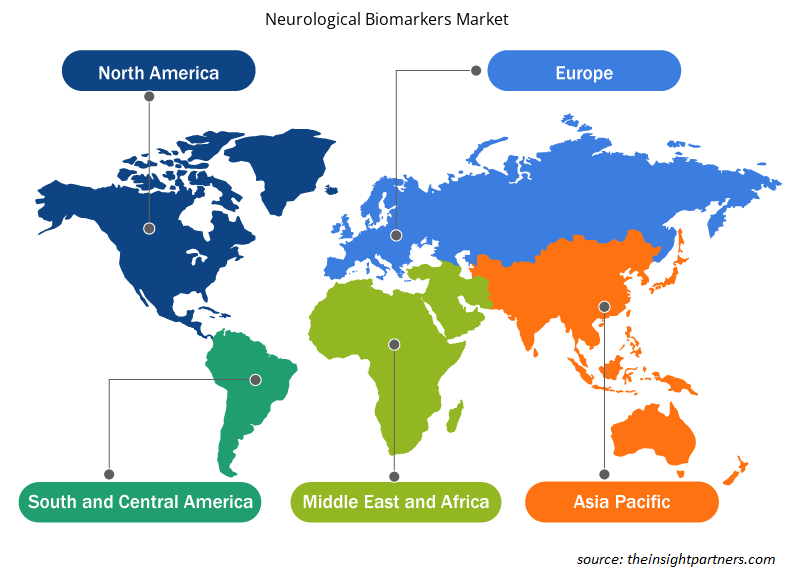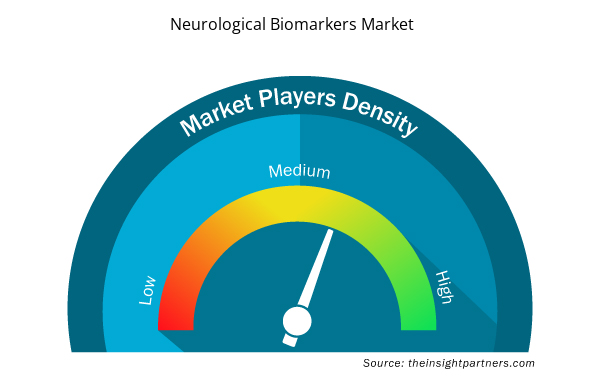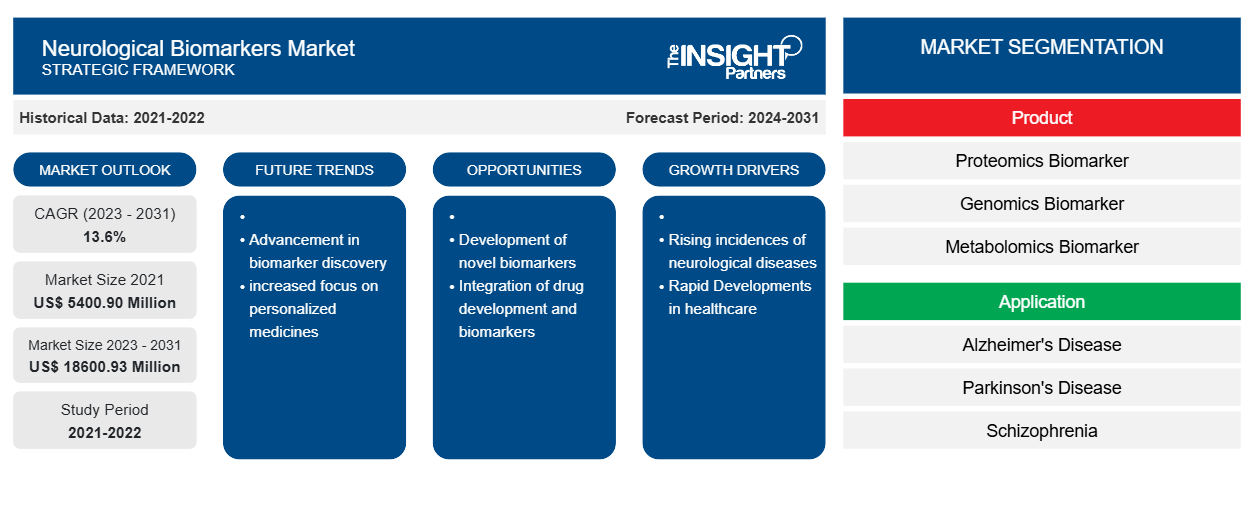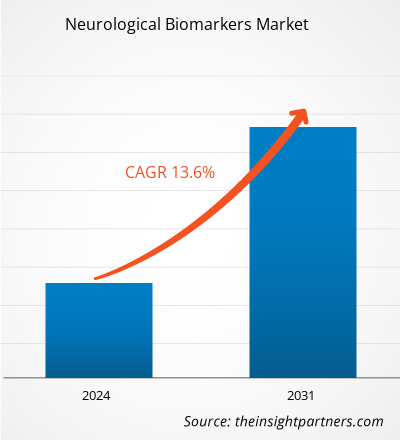神経バイオマーカー市場規模は、2021年に54億90万米ドル、2023年にXX百万米ドルと推定され、2031年までに1億86億93万米ドルに達すると予想されています。2031年には13.6%のCAGRを記録すると予測されています。市場は、神経疾患の有病率の上昇や神経バイオマーカー研究への注目の高まりなどの要因によって牽引されています。ただし、バイオマーカーに関連する懸念は、予測期間中の市場成長を妨げる可能性があります。さらに、ヘルスケア部門全体の急速な発展は、神経バイオマーカー市場の主要トレンドであり続ける可能性があります。
神経バイオマーカー市場分析
神経疾患は、疾患の診断、治療、管理の面で医療システムに大きな負担をかけています。主な神経疾患には、てんかん、アルツハイマー病、多発性硬化症、脊髄性筋萎縮症(SMA)、デュシェンヌ型筋ジストロフィーなどがあります。高齢者は神経疾患にかかりやすいです。神経障害、パーキンソン病、アルツハイマー病、ジストニアは、高齢者に最もよく見られる神経疾患です。米国国立衛生研究所(NIH)によると、世界人口の8.5%(約6億1,700万人)が65歳以上です。世界保健機関(WHO)によると、神経疾患は世界の疾病負担の6.3%を占めており、世界中で主要な死因の1つです。さらに、先進国では死亡の13.2%、低・中所得国では16.8%が神経疾患によるものと報告されています。先進国および新興国における神経疾患の症例の増加が、神経バイオマーカー市場の成長を促進しています。
神経バイオマーカー市場の概要
バイオマーカーとは、病気の存在を示す分子のことです。以前は神経疾患のバイオマーカーはそれほど入手できませんでしたが、技術の進歩により、バイオマーカーを測定することで脳の健康状態を追跡できるようになりました。これにより、病気の早期発見に役立ち、侵襲性の低い診断により薬剤開発が迅速化され、効果的な治療となることが期待されています。
世界の神経系バイオマーカー市場は、地域別に北米、ヨーロッパ、アジア太平洋、中東・アフリカ、中南米に区分されています。北米では、米国が神経系バイオマーカーの最大の市場です。米国における神経系バイオマーカー市場の成長は、市場プレーヤーが市場開発のために有機的および無機的戦略を採用していることに起因しています。たとえば、2020年5月、バイオマーカー分析をデジタル化して精密健康科学を進歩させる企業であるQuanterix Corporationは、すぐに使用できるSimoaキットの強力なメニューを拡張し、脳脊髄液(CSF)、血清、血漿中のアルツハイマー病病理の研究のための非常に特異的な バイオマーカー であるトレオニン181でリン酸化タウ(p-tau181)を含めると発表しました。アルツハイマー協会によると、2020年には65歳以上のアメリカ人のうち推定580万人がアルツハイマー型認知症を患っており、2050年までにその数は1,380万人に達すると予想されています。したがって、神経疾患の罹患率の増加は、予測期間中の市場の成長に有利に働く可能性が高いでしょう。
要件に合わせてレポートをカスタマイズする
このレポートの一部、国レベルの分析、Excelデータパックなど、あらゆるレポートを無料でカスタマイズできます。また、スタートアップや大学向けのお得なオファーや割引もご利用いただけます。
- このレポートの主要な市場動向を入手してください。この無料サンプルには、市場動向から見積もりや予測に至るまでのデータ分析が含まれます。
神経バイオマーカー市場の推進要因と機会
ヘルスケアの急速な発展が市場全体に有利に働く
ヘルスケアと創薬分野の急速な発展により、神経疾患の治療に新たな治療法が導入されつつあります。世界保健機関、国立神経疾患・脳卒中研究所、国立衛生研究所などの当局は、研究活動を奨励し、神経疾患の治療薬を見つけるために建設的な措置を講じています。国立神経疾患・脳卒中研究所 (NINDS) のバイオマーカー プログラムは、神経治療の臨床研究の質と効率を高めることに焦点を当てており、バイオマーカーの検証をサポートしています。このプログラムは、研究活動に資金を提供することで、厳密なバイオマーカーの特定と検証を促進しています。神経変性疾患全体のバイオマーカー (BAND) は、アルツハイマー病 (AD)、パーキンソン病 (PD)、およびその他の神経変性疾患に関する研究分析を促進することを目的としたプログラムです。アルツハイマー協会、アルツハイマー研究英国 (ARUK)、マイケル・J・フォックス・パーキンソン病研究財団 (MJFF)、ウェストン脳研究所 (ウェストン) は、このプログラムに基づいて複数の助成金を提供しています。
このニーズは、予測期間中に世界の神経バイオマーカー市場を牽引する可能性があります。
バイオマーカー発見の進歩 – 神経バイオマーカー市場の機会
近年、バイオマーカーの発見が増加しています。たとえば、2021年4月には、NIHの資金提供を受けた機関のグループがAdvanced Brain Monitoring, Inc.のSleep Profiler EEG睡眠モニターを使用して、神経変性疾患(パーキンソン病と認知症)に関連する2つの新しい睡眠バイオマーカーを発見しました。この発見は神経疾患にとって重要であるだけでなく、バイオマーカーは脳関連の理解にも役立ちます。最近のこのような進歩は、神経バイオマーカー市場に魅力的な成長機会を生み出す可能性があります。
神経バイオマーカー市場レポートのセグメンテーション分析
神経バイオマーカー市場分析の導出に貢献した主要なセグメントは、製品とアプリケーションです。
- 製品に基づいて、プロテオミクスバイオマーカー、ゲノミクスバイオマーカー、メタボロミクスバイオマーカー、イメージングバイオマーカー、その他に分類されます。 2023年には、 ゲノミクス バイオマーカーセグメントが最大の神経バイオマーカー市場シェアを占め、同じセグメントが予測期間中に最速の成長率で成長すると予想されています。 ゲノミクスは、個々の遺伝的変異に基づくパーソナライズされた診断と治療に向けて大きな進歩を遂げています。 ゲノムバイオマーカーは、パーキンソン病、アルツハイマー病、ハンチントン病、自閉症などの神経疾患の特定に使用できることが実証されています。 神経疾患の診断と治療への応用のためのパーソナライズされた医薬品と遺伝子プロファイリングの出現により、今後数年間でこのセグメントの成長が促進されると予想されます。
- アプリケーションセグメントは、アルツハイマー病、パーキンソン病、統合失調症、ハンチントン病、脊髄性筋萎縮症などに分かれています。アルツハイマー病セグメントは2023年に神経バイオマーカー市場で最大のシェアを占め、同じセグメントは2024年から2031年にかけて大幅な成長が見込まれています。アルツハイマー病とは、脳細胞が衰弱(変性)し、最終的には死に至る進行性疾患を指します。病気が進行するにつれて、患者は重度の記憶障害に苦しみ、日常の作業を遂行できなくなります。現在利用可能な薬は、一時的に症状を改善したり、衰退の速度を遅らせたりする可能性があります。この病気の発生率の増加は、今後数年間の神経バイオマーカー市場の成長を説明すると予想されます。
- エンドユーザーに基づいて、市場は製薬およびバイオテクノロジー企業、臨床診断、研究機関に分割されています。 2023年には、製薬およびバイオテクノロジー企業セグメントが最大の市場シェアを占め、同じセグメントは今後数年間で最も速い速度で成長すると予想されています。 したがって、上記の要因が神経バイオマーカー市場規模の成長の原因です。
神経バイオマーカーの地域別市場シェア分析
神経バイオマーカー市場レポートの地理的範囲は、主に北米、アジア太平洋、ヨーロッパ、中東およびアフリカ、南米/中南米の 5 つの地域に分割されています。
アジア太平洋地域は、他のすべての地域の中で最も急速に成長する地域になると予想されています。アジア太平洋地域の市場は、優れた診断および治療ソリューションに対するニーズの高まり、神経疾患の蔓延の増加、研究開発活動への重点の増加などの要因により、より速いペースで成長すると予想されています。さらに、医療インフラの開発と研究活動を促進するための投資の増加は、予測期間中にアジア太平洋の神経バイオマーカー市場を牽引すると予測されています。
神経バイオマーカー市場の地域別洞察
予測期間を通じて神経バイオマーカー市場に影響を与える地域的な傾向と要因は、Insight Partners のアナリストによって徹底的に説明されています。このセクションでは、北米、ヨーロッパ、アジア太平洋、中東、アフリカ、南米、中米にわたる神経バイオマーカー市場のセグメントと地理についても説明します。

- 神経バイオマーカー市場の地域別データを入手
神経バイオマーカー市場レポートの範囲
| レポート属性 | 詳細 |
|---|---|
| 2021年の市場規模 | 54億900万米ドル |
| 2031年までの市場規模 | 1億8600.93万ドル |
| 世界のCAGR(2023年~2031年) | 13.6% |
| 履歴データ | 2021-2022 |
| 予測期間 | 2024-2031 |
| 対象セグメント | 製品別
|
| 対象地域と国 | 北米
|
| 市場リーダーと主要企業プロフィール |
|
神経バイオマーカー市場のプレーヤー密度:ビジネスダイナミクスへの影響を理解する
神経バイオマーカー市場は、消費者の嗜好の変化、技術の進歩、製品の利点に対する認識の高まりなどの要因により、エンドユーザーの需要が高まり、急速に成長しています。需要が高まるにつれて、企業は提供を拡大し、消費者のニーズを満たすために革新し、新たなトレンドを活用し、市場の成長をさらに促進しています。
市場プレーヤー密度とは、特定の市場または業界内で活動している企業または会社の分布を指します。これは、特定の市場スペースに、その規模または総市場価値と比較して、どれだけの競合相手 (市場プレーヤー) が存在するかを示します。
神経バイオマーカー市場で事業を展開している主要企業は次のとおりです。
- サーモフィッシャーサイエンティフィック株式会社
- アボット
- ミリアドジェネティクス株式会社
- バイオ・ラッド ラボラトリーズ株式会社
- キアゲン
- バンヤンバイオマーカーズ株式会社
免責事項:上記の企業は、特定の順序でランク付けされていません。

- 神経バイオマーカー市場のトップキープレーヤーの概要を入手
神経バイオマーカー市場のニュースと最近の動向
神経バイオマーカー市場は、主要な企業出版物、関連データ、データベースを含む一次および二次調査後の定性的および定量的データを収集することによって評価されます。以下は、神経バイオマーカーおよび戦略の市場における動向のリストです。
- 2021年4月、Quantrix Corp.は、pTau181、pTau217、pTau231、およびその他の神経学的バイオマーカーの超高感度定量化に関連する神経学的進歩について議論するために、業界の主要専門家とのウェビナーを発表しました(出典:Quantrix Corp、プレスリリース、2021年)
神経バイオマーカー市場レポートの対象範囲と成果物
「神経バイオマーカー市場規模と予測(2021〜2031年)」レポートでは、以下の分野をカバーする市場の詳細な分析を提供しています。
- 対象範囲に含まれるすべての主要市場セグメントの世界、地域、国レベルでの市場規模と予測
- 市場の動向(推進要因、制約、主要な機会など)
- 今後の主な動向
- 詳細なPEST/ポーターの5つの力とSWOT分析
- 主要な市場動向、主要プレーヤー、規制、最近の市場動向を網羅した世界および地域の市場分析
- 市場集中、ヒートマップ分析、主要プレーヤー、最近の動向を網羅した業界の状況と競争分析
- 詳細な企業プロフィール
- 過去2年間の分析、基準年、CAGRによる予測(7年間)
- PEST分析とSWOT分析
- 市場規模価値/数量 - 世界、地域、国
- 業界と競争環境
- Excel データセット


- Aerosol Paints Market
- Automotive Fabric Market
- Employment Screening Services Market
- Pharmacovigilance and Drug Safety Software Market
- Surety Market
- Personality Assessment Solution Market
- Radiopharmaceuticals Market
- Smart Water Metering Market
- Extracellular Matrix Market
- Artwork Management Software Market

Report Coverage
Revenue forecast, Company Analysis, Industry landscape, Growth factors, and Trends

Segment Covered
This text is related
to segments covered.

Regional Scope
North America, Europe, Asia Pacific, Middle East & Africa, South & Central America

Country Scope
This text is related
to country scope.
Trends and growth analysis reports related to Life Sciences : READ MORE..
The Insight Partners performs research in 4 major stages: Data Collection & Secondary Research, Primary Research, Data Analysis and Data Triangulation & Final Review.
- Data Collection and Secondary Research:
As a market research and consulting firm operating from a decade, we have published and advised several client across the globe. First step for any study will start with an assessment of currently available data and insights from existing reports. Further, historical and current market information is collected from Investor Presentations, Annual Reports, SEC Filings, etc., and other information related to company’s performance and market positioning are gathered from Paid Databases (Factiva, Hoovers, and Reuters) and various other publications available in public domain.
Several associations trade associates, technical forums, institutes, societies and organization are accessed to gain technical as well as market related insights through their publications such as research papers, blogs and press releases related to the studies are referred to get cues about the market. Further, white papers, journals, magazines, and other news articles published in last 3 years are scrutinized and analyzed to understand the current market trends.
- Primary Research:
The primarily interview analysis comprise of data obtained from industry participants interview and answers to survey questions gathered by in-house primary team.
For primary research, interviews are conducted with industry experts/CEOs/Marketing Managers/VPs/Subject Matter Experts from both demand and supply side to get a 360-degree view of the market. The primary team conducts several interviews based on the complexity of the markets to understand the various market trends and dynamics which makes research more credible and precise.
A typical research interview fulfils the following functions:
- Provides first-hand information on the market size, market trends, growth trends, competitive landscape, and outlook
- Validates and strengthens in-house secondary research findings
- Develops the analysis team’s expertise and market understanding
Primary research involves email interactions and telephone interviews for each market, category, segment, and sub-segment across geographies. The participants who typically take part in such a process include, but are not limited to:
- Industry participants: VPs, business development managers, market intelligence managers and national sales managers
- Outside experts: Valuation experts, research analysts and key opinion leaders specializing in the electronics and semiconductor industry.
Below is the breakup of our primary respondents by company, designation, and region:

Once we receive the confirmation from primary research sources or primary respondents, we finalize the base year market estimation and forecast the data as per the macroeconomic and microeconomic factors assessed during data collection.
- Data Analysis:
Once data is validated through both secondary as well as primary respondents, we finalize the market estimations by hypothesis formulation and factor analysis at regional and country level.
- Macro-Economic Factor Analysis:
We analyse macroeconomic indicators such the gross domestic product (GDP), increase in the demand for goods and services across industries, technological advancement, regional economic growth, governmental policies, the influence of COVID-19, PEST analysis, and other aspects. This analysis aids in setting benchmarks for various nations/regions and approximating market splits. Additionally, the general trend of the aforementioned components aid in determining the market's development possibilities.
- Country Level Data:
Various factors that are especially aligned to the country are taken into account to determine the market size for a certain area and country, including the presence of vendors, such as headquarters and offices, the country's GDP, demand patterns, and industry growth. To comprehend the market dynamics for the nation, a number of growth variables, inhibitors, application areas, and current market trends are researched. The aforementioned elements aid in determining the country's overall market's growth potential.
- Company Profile:
The “Table of Contents” is formulated by listing and analyzing more than 25 - 30 companies operating in the market ecosystem across geographies. However, we profile only 10 companies as a standard practice in our syndicate reports. These 10 companies comprise leading, emerging, and regional players. Nonetheless, our analysis is not restricted to the 10 listed companies, we also analyze other companies present in the market to develop a holistic view and understand the prevailing trends. The “Company Profiles” section in the report covers key facts, business description, products & services, financial information, SWOT analysis, and key developments. The financial information presented is extracted from the annual reports and official documents of the publicly listed companies. Upon collecting the information for the sections of respective companies, we verify them via various primary sources and then compile the data in respective company profiles. The company level information helps us in deriving the base number as well as in forecasting the market size.
- Developing Base Number:
Aggregation of sales statistics (2020-2022) and macro-economic factor, and other secondary and primary research insights are utilized to arrive at base number and related market shares for 2022. The data gaps are identified in this step and relevant market data is analyzed, collected from paid primary interviews or databases. On finalizing the base year market size, forecasts are developed on the basis of macro-economic, industry and market growth factors and company level analysis.
- Data Triangulation and Final Review:
The market findings and base year market size calculations are validated from supply as well as demand side. Demand side validations are based on macro-economic factor analysis and benchmarks for respective regions and countries. In case of supply side validations, revenues of major companies are estimated (in case not available) based on industry benchmark, approximate number of employees, product portfolio, and primary interviews revenues are gathered. Further revenue from target product/service segment is assessed to avoid overshooting of market statistics. In case of heavy deviations between supply and demand side values, all thes steps are repeated to achieve synchronization.
We follow an iterative model, wherein we share our research findings with Subject Matter Experts (SME’s) and Key Opinion Leaders (KOLs) until consensus view of the market is not formulated – this model negates any drastic deviation in the opinions of experts. Only validated and universally acceptable research findings are quoted in our reports.
We have important check points that we use to validate our research findings – which we call – data triangulation, where we validate the information, we generate from secondary sources with primary interviews and then we re-validate with our internal data bases and Subject matter experts. This comprehensive model enables us to deliver high quality, reliable data in shortest possible time.


 このレポートの無料サンプルを入手する
このレポートの無料サンプルを入手する